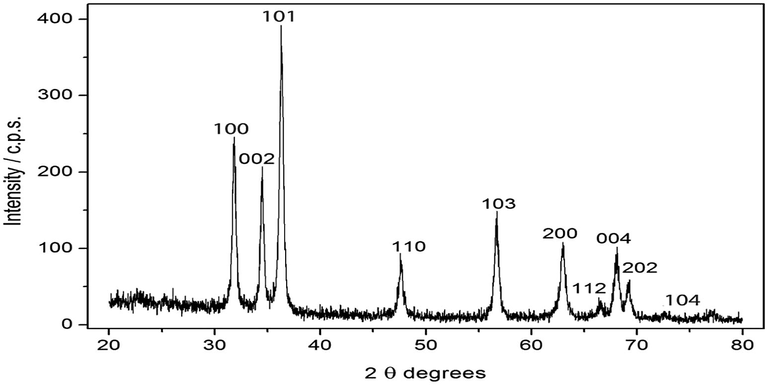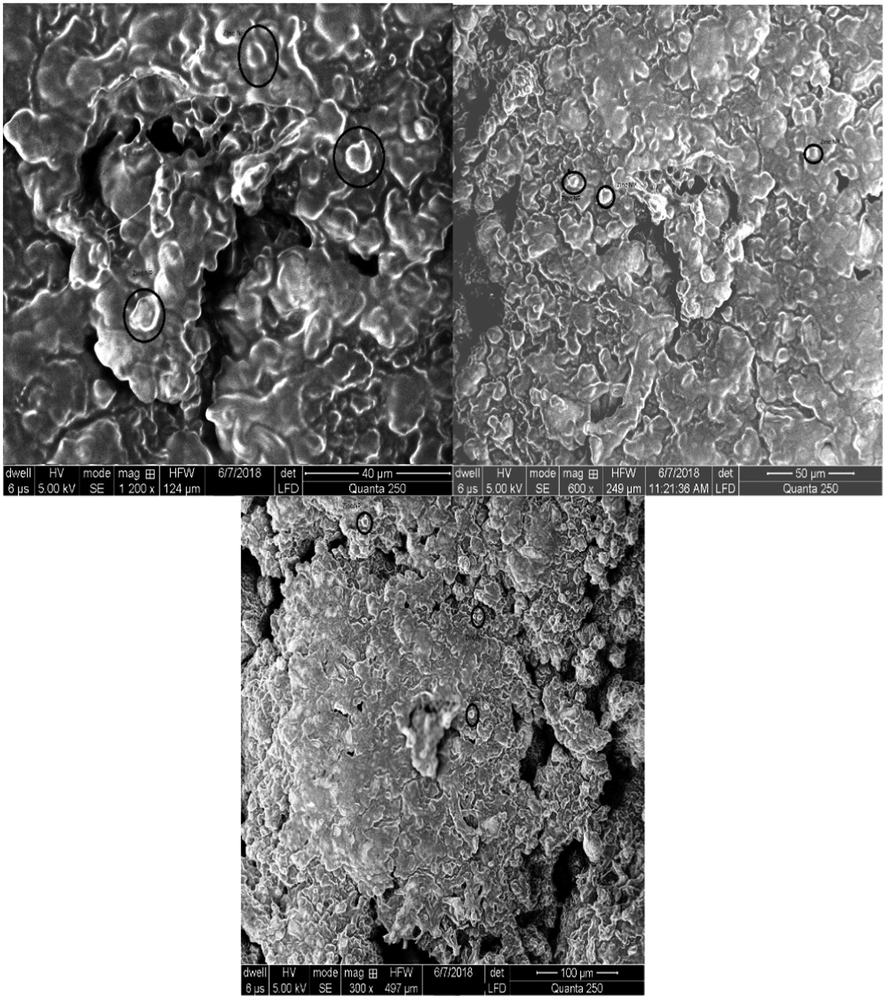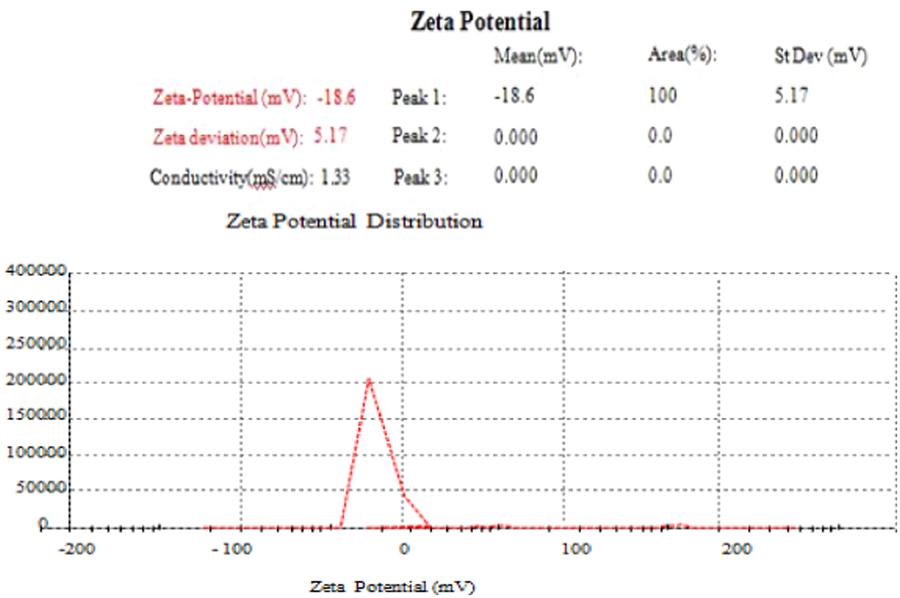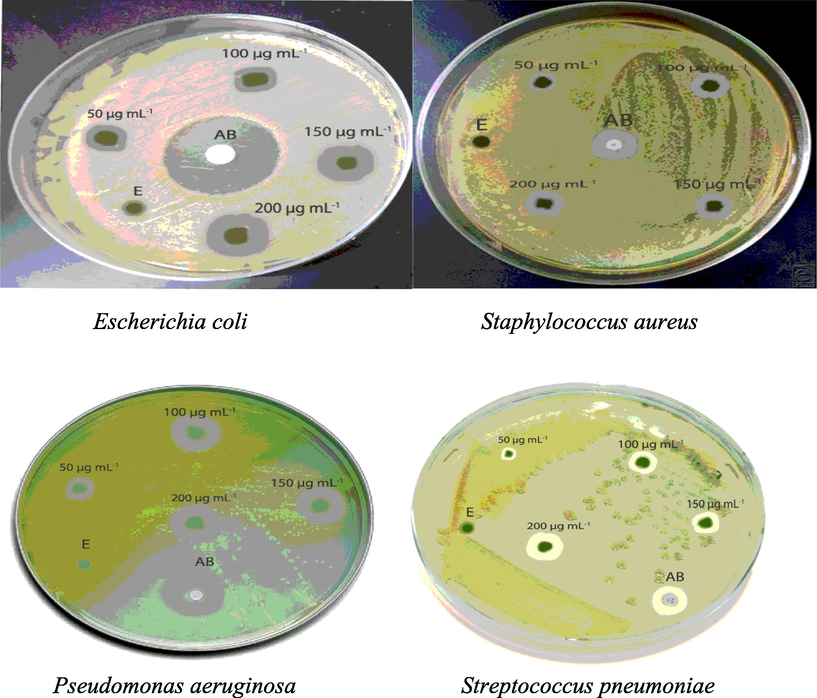Translate this page into:
Eco-friendly synthesis of antibacterial zinc nanoparticles using Sesamum indicum L. extract
⁎Corresponding authors. mhs1049@gmail.com (Muhammad Hussnain Siddique), shahidmahboob60@hotmail.com (Shahid Mahboob)
-
Received: ,
Accepted: ,
This article was originally published by Elsevier and was migrated to Scientific Scholar after the change of Publisher.
Peer review under responsibility of King Saud University.
Abstract
The present study was conducted to prepare cost effective and environment friendly zinc nanoparticles (Zn NPs) by using ZnSO4·7H2O and extract of sesame seeds. Zn NPs were characterized by using scanning electron microscope (SEM), Fourier-transform infrared spectroscopy (FTIR), X-Ray Diffraction and antibacterial potential was checked by using disc diffusion method. Solution colour turned yellow which ultimately confirmed the formation of Zn NPs and seed extract was used as a reducing agent. Crystalline size of the NPs was revealed by XRD spectra i.e. 9.07 nm. Functional groups were identified by the FTIR. SEM analysis given idea about the spherical shape of NPs. Antibacterial activity of the Zn NPs against different bacteria (S. pneumoniae, P. aeruginosa, E. coli and S. aureus) was measured by inhibition zone which ranged from 3.3 to 12.6 mm.
Keywords
Zinc nanoparticles
Characterization
Antibacterial activity
FTIR
XRD
1 Introduction
Nanotechnology aims the production of very small sized particles that have nanoscale dimension (Agarwal et al., 2017, Fazal-ur-Rehman, 2018). A number of chemical and physical approaches are used to synthesize nanoparticles with desired properties but these methods are very expensive, harmful for the humans and environment, labor intensive, toxic and high amount of energy and pressure is required for their proper completion (Taheriniya and Behboodi, 2016). NPs are biologically produced by plants, algae, fungi, bacteria, diatoms and human cells. Plants are preferred among all the green synthesis routes for nanoparticles (Makarov et al., 2014, Mirzaei and Darroudi, 2017).
Characteristics of nanoparticles as well as their stability, size and shape are greatly affected by the temperature, concentration, pH and many other factors during the formation process (Shah et al., 2015). Different kinds of NPs including gold, iron, zinc, silver, copper, platinum as well as oxides of metals and non-metals etc are formed from prokaryotes and eukaryotes (Hasan, 2015).
Among all, Zn NPs are preferred because they can generate ROS and are good semiconductors (Malaikozhundan, 2018, Srivastava et al., 2013). Characteristics of Zn NPs depend on their size, concentration and shape (Siddiqi et al., 2018). Extracts of the plants are used as bioreductant and capping agent for producing NPs (Shaik et al., 2018). Phytomolecules (Stephen and Seethalakshmi, 2013) and secondary metabolites present in plants extract play vital role during nanoparticle synthesis (Marslin et al., 2018, Mourdikoudis et al., 2018).
Sesamum indicum L. is known as Queen of oilseeds. It is rich in the natural antioxidants (Pathak et al., 2014). During green synthesis, extract of the sesame is used as reducing and gelling agent (Manikandan et al., 2016).
The aim of this study was the production of the Zn NPs by green method through bio-reduction using Sesame seed extract, and to check their antibacterial potential.
2 Materials and methods
2.1 Seeds extraction
Sesame seeds were washed using distilled water, dried and then grinded. The seed powder (20 g) was mixed with the distilled water (100 ml), boiled for 45 min at 75 °C (Saravanakkumar et al., 2016). Extract was collected and stored at 4 °C.
2.2 Preparation of Zn NPs
Zinc nanoparticles were prepared by adding 20 ml of the sesame seed extract in 80 ml of the 1 mM ZnSO4·7H2O solution. Sonicate solution for 1 h at 60 °C. A change in the color to yellow indicated the formation of Zn NPs (Eya’ane Meva et al., 2016).
2.3 Characterization
Diameter of crystalline Zn NPs was determined by using X-Ray diffraction by Scherrer’s equation i.e.
where t = size of the crystallite, k = shape factor, λ = wavelength of radiation.
2.4 SEM and FTIR
SEM was used for scanning surface of sample. Qualitative and quantitative examination as well as functional groups in the sample was determined by Fourier Transform Infrared Spectroscopy (FTIR) (Eya’ane Meva et al., 2016).
2.5 Zeta potential
Stability of NPs was dogged by zeta potential (Saranya et al., 2017).
2.6 Antibacterial potential
Antibacterial potential of the Zn NPs was examined using Kirby-Bauer standard disc diffusion process by various dilutions (50, 100, 150 and 200 µg/mL) of Zn NPs (Velusamy et al., 2015). The application of bacterial suspension (100 µL) on the surface of nutrient agar plate was done overnight. Antibacterial disc (Gentamicin), discs coated with different concentrations of Zn NPs and seed extract placed on the inoculated plates then kept in incubator for 24 h at 37 °C. After that, inhibition zone was noticed around each disc.
2.7 Statistical analysis
The data was statistically analyzed by analysis of variance technique using completely randomized design in factorial arrangement.
3 Results
3.1 XRD analysis
The XRD diffraction spectrum of green synthesized Zn NPs exhibited peaks at 2θ (32.171, 34.901, 36.807, 48.631, 57.473, 63.701, 68.202) conforming to Zn (1 0 0), (0 0 2), (1 0 1), (1 1 0), (1 0 3), (2 0 0) and (0 0 4) planes of the standard XRD. The XRD design suggested that zinc nanoparticles were crystalline in the nature. The XRD pattern revealed a strong plane of zinc at 101 and other weaker planes (Fig. 1). The average size of Zn NPs was determined as 9.07 nm.
XRD pattern of the Zn NPs.
3.2 FTIR analysis
FTIR spectroscopy is an effective approach for determining the major functional groups (reduced bio-molecules) necessary for the green synthesis of NPs via the reduction and stabilization of Zn ions. The FTIR spectrum revealed a number of absorption bands (Fig. 2; Table 1). Peaks were observed at 428.73, 728.18, 1021.33, 1458.56, 1563.78, 2845.31, 2944.14 and 3425.88 cm−1. At 728.18 cm−1 and 1021.33 cm−1 absorption band revealed the existence of C–H bending of the aromatic alkanes, alkenes, alkynes and aromatic hydrocarbons. Similarly, presence of N–H bending (Primary, secondary amines and amides) and C–H bending was confirmed by peaks at the 1458.56 cm−1 and 1563.78 cm−1. At the peak of 2845.31 cm−1 alcohol was observed with C–O vibrations. Existence of C=O functional group of carboxylic acid in addition with ketones and aldehydes was confirmed by peak at the 2944.14 cm−1. Presence of the O–H vibration of phenol and alcohols was revealed by the absorption band at the 3425.88 cm−1. All these vibrations showed that various biomolecules are involved in stabilization and reduction of NPs.
Frequencies cm-1
Functional group
Type of vibrations
428.73
Zn-O
Stretching vibration
728.18
C–H
Bending vibration (alkanes, alkynes, alkenes and aromatic hydrocarbons)
1021.33
C–H
Bending vibration (aromatic hydrocarbons)
1458.56
C–H
N–HBending vibration (Primary and secondary amides and amines as well as aromatic hydrocarbons)
1563.78
C–H
N–HBending vibration (Primary and secondary amides and amines as well as aromatic hydrocarbons)
2845.31
C–O
Stretching vibration (alcohols)
2944.14
C=O
Stretching vibration (carboxylic acids, ketones and aldehydes)
3425.88
O–H
Stretching vibration (alcohols and phenols)

FTIR spectrum of Zn NPs.
3.3 SEM analysis
SEM analysis verified the presence of the Zn NPs created by treating zinc sulfate solution with Sesamum indicum seed extract. SEM revealed about average size of NPs as 70 nm as well as about their spherical shape. The shape and size of the NPs depend on extract concentration and ratio of zinc sulfate to the seed extract (Fig. 3).
SEM images showing spherical Zn NPs with size of 70 nm.
3.4 Zeta potential
Surface charge of Zn NPs was determined by zeta potential. Zeta potential measured stability of NPs as −18.6 mV (Fig. 4).
Zeta potential measured stability of NPs as −18.6 mV.
3.5 Antibacterial potential
Antibacterial strength of synthesized Zn NPs was examined using Kirby-Bauer disc diffusion process. Different dilutions (50, 100, 150 and 200 µg/mL) of the NPs were checked against E. coli, P. aeruginosa, (gram negative), S. aureus and S. pneumoniae (gram positive) (Fig. 5). Solution of 200 µg/mL revealed the highest zone of inhibition against bacteria (Tables 2 and 3). In comparison of inhibition zone of Zn NPs, antibiotic (gentamicin) was used as a standard. Zones of inhibition were present in range of 3.3–12.6 mm. NPs cause severe damage to the target by attacking its cell membrane and cell wall and disturbing its whole functioning.
AB antibiotic (Gentamicin), E (seed extract), 50, 100, 150 and 200 µg/ml are dilutions of Zn NPs).
Bacteria
Extract
Gentamicin
50 µg/ml
100 µg/ml
150 µg/ml
200 µg/ml
Escherichia coli
A
–
13 mm
3.7 mm
5.6 mm
9.7 mm
10.4 mm
Pseudomonas aeruginosa
B
–
13.9
4.1
9.2
9.9
12.6
Staphylococcus aureus
C
–
13.3
_
3.3
3.7
4.1
Streptococcus pneumoniae
D
–
14.6
_
6.3
8.2
8.6
Source
df
SS
MS
F
P
Bacterial strains (BS)
3
170.045
56.682
1162.7009
0.000***
Treatments (T)
5
1472.28
294.456
6040.123
0.000***
Interaction
BS × T
15
125.65
8.37
171.829
0.000***
Error
48
2.34
0.048
Total
71
1770.315
4 Discussion
Sesamum indicum seed extract was used for the preparation of green eco-friendly Zn NPs as the bio-molecules in the leaf extract are effective in stabilizing the Zn NPs (Al-Dhabi and Valan Arasu, 2018). A change in extract color with ZnSO4 solution showed reduction in zinc ions which confirmed the formation of Zn NPs. Formation of the Zn NPs was revealed by yellow colour appearance (Bisquera et al., 2017). In the biological methods nanoparticles are formed by the reduction of metal salt, as metal salt and extract mixed together (Sirisha and Mary, 2016).
In the medicinal field Zn NPs are gaining much importance due to their strong antibacterial activity as depicted in our study (Elshama et al., 2018). Characterization of the NPs is done by using highly precise techniques i.e. XRD (Sharma et al., 2012), SEM (Hodoroaba et al., 2016), Zeta potential (Clogston and Patri, 2011) and FTIR (Devaraj et al., 2013). By using XRD analysis formation of Zn NPs was determined with average size 9.07 nm and spectral analysis showed the nature of crystallization of particles and their crystalline nature (Vijayakumar et al., 2018).
Biological molecules involved in stabilizing the Zn Nps were determined by FTIR. The main peaks showed primary and secondary amides and amines, proteins, alcohols, aromatic hydrocarbons, aldehydes, ketones and carboxylic acids as well as stretching and bending vibrations proved that all these are connected with Zn NPs (Jamdagni et al., 2018). SEM analysis revealed average size of Zn NPs i.e. 70 nm, shape as spherical and also revealed about the surface morphology (Santhoshkumar et al., 2017). SEM revealed that formation of NPs with larger size take place because of evaporation of solvent in preparation process which ultimately led to variation in particle size. Zeta potential of the Zn NPs depicted that prepared NPs are stable (Kim et al., 2014).
Sesmum indicum seed extract mediated Zn NPs exhibited high antibacterial potential against different bacteria P. aeruginosa (Hoseinzadeh et al., 2014), E. coli (Şahin et al., 2017), S. aureus (Mostafa, 2015) and S. pneumoniae (Bhattacharyya et al., 2018). Antibacterial potential of Zn NPs was proved from the calculations of inhibition zone. Inhibition zone of 12.6 mm was considered as a largest zone (Palanikumar et al., 2014).
5 Conclusion
Present study suggested that biological method of Zn NPs synthesis is the most economical, reliable and easy way to synthesize NPs, as a green synthesis method. The characterization through XRD spectra revealed about the size and nature of NPs, the size and shape of NPs have direct relation with the concentration of seed extract and relative amount of zinc sulfate heptahydrate to extract. SEM images revealed 70 nm size along with spherical shape of NPs. FTIR revealed that bio-molecules are responsible for the stabilization and reduction of the NPs. Zeta potential dogged the stability of Zn NPs. Green synthesized Zn NPs possess greater antibacterial activity against various bacteria (S. pneumonia, P. aeruginosa, S. aureus and E. coli). This study illustrates new and easy way for green synthesized Zn NPs with numerous uses in the medicinal field.
Acknowledgements
The facilities and support provided by the Department of Botany and Zoology, Government College University Faisalabad are highly acknowledged. “The authors (KAAG, FAM and SM) express their sincere appreciation to the Researchers Supporting Project (RSP-2019-93), King Saud University, Riyadh, Saudi Arabia”.
Conflict of interest
There were no competing interests among authors.
References
- A review on green synthesis of zinc oxide nanoparticles – an eco-friendly approach. Resour. Effic. Technol.. 2017;3:406-413.
- [Google Scholar]
- Environmentally-friendly green approach for the production of zinc oxide nanoparticles and their anti-fungal, ovicidal, and larvicidal properties. Nanomaterials. 2018;8(7):500.
- [Google Scholar]
- Zinc oxide nanoparticle inhibits the biofilm formation of Streptococcus pneumoniae. Antonie Van Leeuwenhoek. 2018;111(1):89-99.
- [Google Scholar]
- Synthesis and characterization as zinc oxide nanoparticles as a source of zinc micronutrient in organic fertilizer. Int. J. Agric. Technol.. 2017;13(7.2):1695-1706.
- [Google Scholar]
- Zeta potential measurement. In: Characterization of Nanoparticles Intended for Drug Delivery. Humana Press; 2011. p. :63-70.
- [Google Scholar]
- Synthesis and characterization of silver nanoparticles using cannonball leaves and their cytotoxic activity against MCF-7 cell line. J. Nanotechnol.. 2013;2013
- [Google Scholar]
- Zinc oxide nanoparticles: therapeutic benefits and toxicological hazards. Open Nanomed J.. 2018;5(1):1-13.
- [Google Scholar]
- Spectroscopic synthetic optimizations monitoring of silver nanoparticles formation from Megaphrynium macrostachyum leaf extract. Rev. Bras. Farmacog.. 2016;26(5):640-646.
- [Google Scholar]
- Novel applications of nanomaterials and nanotechnology in medical sciences-a review. J. Basic Appl. Sci. Res.. 2018;8(4):1.
- [Google Scholar]
- A review on nanoparticles: their synthesis and types biosynthesis: mechanism. Res. J. Recent. Sci.. 2015;4:9-11.
- [Google Scholar]
- Characterisation of nanoparticles by means of high-resolution SEM/EDS in transmission mode. IOP Conference Series: Mater. Sci. Eng.. 2016;109(1):012006
- [Google Scholar]
- Antimicrobial potential of synthesized zinc oxide nanoparticles against gram positive and gram negative bacteria. Desalin. Water Treat.. 2014;52(27):4969-4976.
- [Google Scholar]
- Green synthesis of zinc oxide nanoparticles using flower extract of Nyctanthes arbortristis and their antifungal activity. J. King Saud Univ. Sci.. 2018;30(2):168-175.
- [Google Scholar]
- Physicochemical properties of surface charge-modified ZnO nanoparticles with different particle sizes. Int. J. Nanomed.. 2014;9(2):41.
- [Google Scholar]
- Green nanotechnologies: synthesis of metal nanoparticles using plants. Acta Naturae. 2014;6(1):20.
- [Google Scholar]
- Pharmaceutical applications of zinc oxide nanoparticles-a review. Acta Sci. Pharm. Sci.. 2018;2(1):11-12.
- [Google Scholar]
- Sesamum indicum plant extracted microwave combustion synthesis and opto-magnetic properties of spinel MnxCo1-xAl2O4 nano-catalysts. J. Nanosci Nanotechnol.. 2016;16(1):448-456.
- [Google Scholar]
- Secondary metabolites in the green synthesis of metallic nanoparticles. Materials.. 2018;11(6):940.
- [Google Scholar]
- Antibacterial activity of zinc oxide nanoparticles against toxigenic Bacillus cereus and Staphylococcus aureus isolated from some Egyptian food. Int. J.. 2015;6(2):145-154.
- [Google Scholar]
- Zinc oxide nanoparticles: Biological synthesis and biomedical applications. Ceram. Int.. 2017;43(1):907-914.
- [Google Scholar]
- Characterization techniques for nanoparticles: comparison and complementarity upon studying nanoparticle properties. Nanoscale. 2018;10(27):12871-12934.
- [Google Scholar]
- Value addition in sesame: a perspective on bioactive components for enhancing utility and profitability. Pharmacogn. Rev.. 2014;8(16):147.
- [Google Scholar]
- Size-dependent antimicrobial response of zinc oxide nanoparticles. IET Nanobiotechnol.. 2014;8(2):111-117.
- [Google Scholar]
- Antibacterial activity against Escherichia coli and characterization of ZnO and ZnO–Al2O3 mixed oxide nanoparticles. Arab. J. Chem.. 2017;10(1):230-235.
- [Google Scholar]
- Synthesis of zinc oxide nanoparticles using plant leaf extract against urinary tract infection pathogen. Resour.-Effic. Technol.. 2017;3(4):459-465.
- [Google Scholar]
- Green synthesis of metallic nanoparticles using aqueous plant extract and their antibacterial activity. Int. J. Curr. Microbiol. Appl. Sci.. 2017;6(6):1834-1845.
- [Google Scholar]
- Green synthesis of ZnO nanoparticles using trachyspermum ammi seed extract for antibacterial investigation. Pharm. Chem.. 2016;8(7):173-180.
- [Google Scholar]
- Green synthesis of metallic nanoparticles via biological entities. Materials. 2015;8(11):7278-7308.
- [Google Scholar]
- Plant-extract-assisted green synthesis of silver nanoparticles using Origanum vulgare L. extract and their microbicidal activities. Sustainability. 2018;10(4):913.
- [Google Scholar]
- X-ray diffraction: a powerful method of characterizing nanomaterials. Recent Research in Science and Technology. 2012;4(8):77-79.
- [Google Scholar]
- Properties of zinc oxide nanoparticles and their activity against microbes. Nanoscale Res Lett.. 2018;13(1):141.
- [Google Scholar]
- Green synthesis of nanoparticle of zinc and treatment of nanobeads for wastewater of alizarin red dye. Int. J. Environ. Res. Develop.. 2016;6:11-16.
- [Google Scholar]
- Synthesis, characterization and application of zinc oxide nanoparticles (n-ZnO) Ceram. Int.. 2013;39(8):9803-9808.
- [Google Scholar]
- Phytochemical synthesis and preliminary characterization of silver nanoparticles using hesperidin. J Nanosci. 2013:1-7.
- [Google Scholar]
- Comparing green chemical methods and chemical methods for the synthesis of titanium dioxide nanoparticles. Int. J. Pharm. Sci. Res.. 2016;7(12):4927-4932.
- [Google Scholar]
- Greener approach for synthesis of antibacterial silver nanoparticles using aqueous solution of neem gum (Azadirachta indica L.) Ind. Crops Prod.. 2015;66(1):103-109.
- [Google Scholar]
- Biosynthesis, characterization and antimicrobial activities of zinc oxide nanoparticles from leaf extract of Glycosmis pentaphylla (Retz.) DC. Microb. Pathogen.. 2018;116:44-48.
- [Google Scholar]







